|
ONE great character of the Indian culinary scene is my friend Imtiaz Qureshi, the world-famous dum pukth khana cook. He is the only Indian chef I know who has made Newsweek�s cover. And who, at 71, is still happily occupied in improvising his unique cuisine. As recently as the first week of November, Qureshi was in Bombay, showcasing 14 new dum pukth dishes at a food festival in ITC�s Grand Maratha Sheraton. The hotel�s PR lady, Bindu Panicker, called: �Chef Imtiaz Qureshi is here, he�s asking for you, would you like to come and have dinner with him?� I would, certainly, and thank-you. And one Diwali night, I drove across Bombay to have a dum pukth dinner with Qureshi, reviving memories of a friendship that was made in 1990, when he came to Bombay to start the SeaRock Sheraton�s Dum Pukth restaurant. Twelve years ago Qureshi looked old. Today at 71, he still looks old, but not a day older than he did when I first met him.
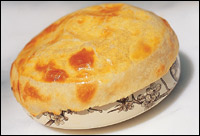 He is a large, jolly man, built in the classic mould of all good chefs, with a twirling moustache, twinkling grey eyes and silver hair. Without his chef�s apron and toque, Qureshi is a dead ringer for Santa Claus. And he is a passionate and garrulous old man. Get him onto a discussion on dum pukth food, which is his favourite hobby horse, and Qureshi will not let go of you in a hurry. I recall my first meeting with him. I discovered that he could neither read nor write. But he could talk. Unfortunately, he spoke a Lucknowi Urdu that was so chaste I needed an interpreter at the time to understand him. Since then, over several dum pukth dinners, I have come to understand the man and his cuisine. These dinners were mostly at the ITC�s Maurya Sheraton in Delhi where Qureshi is the presiding deity. He started India�s first Dum Pukth restaurant there. And also a Bukhara, which is still running over 25 years later with his original menu of North-West Frontier Province cuisine.
He is a large, jolly man, built in the classic mould of all good chefs, with a twirling moustache, twinkling grey eyes and silver hair. Without his chef�s apron and toque, Qureshi is a dead ringer for Santa Claus. And he is a passionate and garrulous old man. Get him onto a discussion on dum pukth food, which is his favourite hobby horse, and Qureshi will not let go of you in a hurry. I recall my first meeting with him. I discovered that he could neither read nor write. But he could talk. Unfortunately, he spoke a Lucknowi Urdu that was so chaste I needed an interpreter at the time to understand him. Since then, over several dum pukth dinners, I have come to understand the man and his cuisine. These dinners were mostly at the ITC�s Maurya Sheraton in Delhi where Qureshi is the presiding deity. He started India�s first Dum Pukth restaurant there. And also a Bukhara, which is still running over 25 years later with his original menu of North-West Frontier Province cuisine.
Qureshi has much to thank the ITC Welcomgroup Hotels for. Before they made him famous by installing him at the Maurya and making him corporate chef for Indian cuisine, he was the head chef of the famous Clarke�s Hotel in Lucknow. And before that, a caterer for Mughlai food in the old city. Even before that (you don�t want to know!), Qureshi was Lucknow�s champion wrestler and known simply as Imtiaz Pehelwan! I don�t know anything about this part of his life, but beneath his ageing frame, he still has the ghost of what he must have been like in his fighting days. A strong and burly body, and the large hands of a wrestler. When you meet him, ask him to hold out his hands. Qureshi will oblige. Take a good look at his palms. You will not see such big palms on many men. He uses them to measure all the spices that go into his dum pukth recipes. Because he cannot read nor write, Qureshi does not understand measures, but he has a natural feel for ingredients. �I have an andaz,� he explained to me. �I measure the ingredients in my palm, I know by instinct, by experience, whether what I am holding is enough, or if it is more or less.�
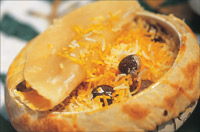 Before I come to the food, I will attempt to explain what dum pukth cooking is all about. But to catch the aromas, flavours and tastes of Qureshi�s cooking, you will have to go to Delhi and dine with him at the Maurya Sheraton�s Dum Pukth restaurant. My writing cannot bring that out. �Dum� means steam, and �dum pukth� literally means to choke off the steam. Dum is the predecessor of the modern day slow-cooking method. Food, that is meat, fish, vegetables, is partially cooked with all accompaniments, and then placed in a handi which is sealed with a ring of atta. This is to ensure that during the cooking, the moisture remains within, and the food cooks in its own juices. The handi is then placed on a sigdi of burning coals. At the same time, smouldering coals are placed on the lid so that the food is given heat from top and bottom. The food cooks in its steam and retains all the flavour and aroma of the ingredients. The �dum� given all over also brings the ghee, or oil, in the food to the top, improving the appearance of the dish.
Before I come to the food, I will attempt to explain what dum pukth cooking is all about. But to catch the aromas, flavours and tastes of Qureshi�s cooking, you will have to go to Delhi and dine with him at the Maurya Sheraton�s Dum Pukth restaurant. My writing cannot bring that out. �Dum� means steam, and �dum pukth� literally means to choke off the steam. Dum is the predecessor of the modern day slow-cooking method. Food, that is meat, fish, vegetables, is partially cooked with all accompaniments, and then placed in a handi which is sealed with a ring of atta. This is to ensure that during the cooking, the moisture remains within, and the food cooks in its own juices. The handi is then placed on a sigdi of burning coals. At the same time, smouldering coals are placed on the lid so that the food is given heat from top and bottom. The food cooks in its steam and retains all the flavour and aroma of the ingredients. The �dum� given all over also brings the ghee, or oil, in the food to the top, improving the appearance of the dish.
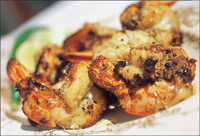 The cuisine is over 200 years old. The story goes that a famine had ravaged the state of Awadh during the time of the benevolent Nawab Asaf-ud-Daulah in 1784. People were starving and jobs were unavailable. To create employment, the Nawab ordered the construction of a giant edifice, the Bara Imambara. And whatever was constructed by day, was destroyed at night, so that Asaf-ud-Daulah�s people were constantly busy. He had given them unceasing employment.
The cuisine is over 200 years old. The story goes that a famine had ravaged the state of Awadh during the time of the benevolent Nawab Asaf-ud-Daulah in 1784. People were starving and jobs were unavailable. To create employment, the Nawab ordered the construction of a giant edifice, the Bara Imambara. And whatever was constructed by day, was destroyed at night, so that Asaf-ud-Daulah�s people were constantly busy. He had given them unceasing employment.
Arrangements were made to provide the workers with food. Enormous containers were filled with rice, meat, vegetables and spices to make a simple, one-dish meal. These gigantic copper handis or degs were sealed, hot charcoal was placed on top and fires lit underneath, and the slow cooking ensured that warm food was available day and night. One night, when the vessels were unsealed, the splendid aromas attracted royal attention. Nawab Asaf-ud-Daulah decided to sample the food himself. He is believed to have relished every morsel. After which he quickly invented a massive double-walled, oven-like structure known today as the bukhari. And the bawarchis of his royal kitchen experimented further with the dum cooking using exotic spices and herbs so that the one-dish meal prepared for the humble Awadhis became royal delicacies fit for the sovereign at banquets and hunts. 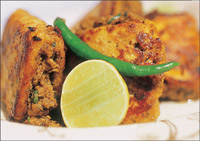 I am told that this wonderful Awadhi cuisine then found a champion in India�s best known Mughlai gourmet, the legendary Nawab Wajid Ali Shah, after whom dishes are named on various Mughlai menus. Legend has it that this Nawab took dum pukth cooking a step higher. His bawarchis were in constant competition to create new, exotic dishes for the Nawab. And they embellished the dum pukth style of cooking with aromatic ingredients, dried fruits, and aphrodisiacs that delighted the insatiable Nawab no end and engaged the services of his vast harem full-time. I don�t know how far this story is true, but on his new 14-dish menu, Imtiaz Qureshi does have one dish that he credits to Nawab Wajid Ali Shah. It is the Nucklawai Dum Ki Chaap. Qureshi uses chunky mutton chops and original spices from Lucknow. The meat is slow cooked on dum in a traditional Awadhi dish called the lagan. When it is ready, it is rich and aromatic, and the meat, soft to touch, falls apart when you reach out for it. It is a time-honoured recipe in Lucknow. Nawab Wajid Ali Shah asked for it just before he could be incarcerated by the British.
I am told that this wonderful Awadhi cuisine then found a champion in India�s best known Mughlai gourmet, the legendary Nawab Wajid Ali Shah, after whom dishes are named on various Mughlai menus. Legend has it that this Nawab took dum pukth cooking a step higher. His bawarchis were in constant competition to create new, exotic dishes for the Nawab. And they embellished the dum pukth style of cooking with aromatic ingredients, dried fruits, and aphrodisiacs that delighted the insatiable Nawab no end and engaged the services of his vast harem full-time. I don�t know how far this story is true, but on his new 14-dish menu, Imtiaz Qureshi does have one dish that he credits to Nawab Wajid Ali Shah. It is the Nucklawai Dum Ki Chaap. Qureshi uses chunky mutton chops and original spices from Lucknow. The meat is slow cooked on dum in a traditional Awadhi dish called the lagan. When it is ready, it is rich and aromatic, and the meat, soft to touch, falls apart when you reach out for it. It is a time-honoured recipe in Lucknow. Nawab Wajid Ali Shah asked for it just before he could be incarcerated by the British.
And the Murgh Galaoti Sangam on Qureshi�s menu is also new, chicken supremes stuffed with the famed galaoti mince, a recipe that the great chef was introduced to by Nawab Ali Yuvar Jung when he was governor in Bombay. Likewise, the Turush-e-Paneer that Qureshi first prepared for Pandit Jawaharlal Nehru during the Indo-China border conflict of 1962. C. B. Gupta, chief minister of Uttar Pradesh, who played host to Nehru, ordered a vegetarian repast no less in taste or variety than his chef�s famous non-vegetarian repertoire. Qureshi stuffed slices of cottage cheese with dried plum, oranges and covered it with tomato plum sauce. He has a story behind each of his 14 creations. How he adapted other memorable dishes to his fundamentals, how each dish was created for occasions that necessitated something different for valued guests who always demanded something �special� to honour the occasion. The mind is still sharp, the recollection accurate to the minutest detail. �The Mahi Dum Pukth in which I use red snapper fillets with an almond and brown onion sauce and cook on a slow oven, I evolved in 1972 for the wedding of a socialite�s daughter in Bombay,� he told me. 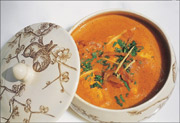 There is a Jhinga Kali Mirch, tiger prawns subtly dredged in black peppercorns, cumin, ginger, then charcoal grilled. Qureshi created this recipe for the opening of ITC�s Windsor Manor in Bangalore in 1982. A Lab-e-Mahshoukh dessert, India�s parallel to Peach Melba, pista kulfi with sour cherry sauce. Qureshi created this one for Begum Akhtar, the Queen of Ghazals, just like the renowned French chef of the early 20th century, August Escoffier, created Peach Melba for Dame Melba. And another dessert, Shamsheer Aatish-e-Shirni, apple jelebis flamed with dark rum, was dedicated to Field Marshal Cariappa after he had commissioned the NCC in Lucknow in 1948. �By Allah�s grace, I am always meeting people with a taste for food and a story to tell. I soak information like a computer. Once I do that, once a I get a new recipe in my hand, I turn it around. Recipes are like languages, each one is different, but not so difficult that you cannot adopt it to suit your tongue. I learn it and master it.� And that is how it has been with Imtiaz Qureshi who began his romance with Mughlai food when he was nine, and who, at 71, still puts in a full day at the Maurya Sheraton�s kitchen. �The secret of a successful dish,� he said to me affectionately, �is that it must be prepared with love and respect. For the guest and for the food. Dil se, dimag se, mehnat se.�
There is a Jhinga Kali Mirch, tiger prawns subtly dredged in black peppercorns, cumin, ginger, then charcoal grilled. Qureshi created this recipe for the opening of ITC�s Windsor Manor in Bangalore in 1982. A Lab-e-Mahshoukh dessert, India�s parallel to Peach Melba, pista kulfi with sour cherry sauce. Qureshi created this one for Begum Akhtar, the Queen of Ghazals, just like the renowned French chef of the early 20th century, August Escoffier, created Peach Melba for Dame Melba. And another dessert, Shamsheer Aatish-e-Shirni, apple jelebis flamed with dark rum, was dedicated to Field Marshal Cariappa after he had commissioned the NCC in Lucknow in 1948. �By Allah�s grace, I am always meeting people with a taste for food and a story to tell. I soak information like a computer. Once I do that, once a I get a new recipe in my hand, I turn it around. Recipes are like languages, each one is different, but not so difficult that you cannot adopt it to suit your tongue. I learn it and master it.� And that is how it has been with Imtiaz Qureshi who began his romance with Mughlai food when he was nine, and who, at 71, still puts in a full day at the Maurya Sheraton�s kitchen. �The secret of a successful dish,� he said to me affectionately, �is that it must be prepared with love and respect. For the guest and for the food. Dil se, dimag se, mehnat se.�
|



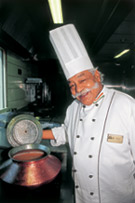 The Shahenshah Of Dum Pukth Cooking!
The Shahenshah Of Dum Pukth Cooking!
 He is a large, jolly man, built in the classic mould of all good chefs, with a twirling moustache, twinkling grey eyes and silver hair. Without his chef�s apron and toque, Qureshi is a dead ringer for Santa Claus. And he is a passionate and garrulous old man. Get him onto a discussion on dum pukth food, which is his favourite hobby horse, and Qureshi will not let go of you in a hurry. I recall my first meeting with him. I discovered that he could neither read nor write. But he could talk. Unfortunately, he spoke a Lucknowi Urdu that was so chaste I needed an interpreter at the time to understand him. Since then, over several dum pukth dinners, I have come to understand the man and his cuisine. These dinners were mostly at the ITC�s Maurya Sheraton in Delhi where Qureshi is the presiding deity. He started India�s first Dum Pukth restaurant there. And also a Bukhara, which is still running over 25 years later with his original menu of North-West Frontier Province cuisine.
He is a large, jolly man, built in the classic mould of all good chefs, with a twirling moustache, twinkling grey eyes and silver hair. Without his chef�s apron and toque, Qureshi is a dead ringer for Santa Claus. And he is a passionate and garrulous old man. Get him onto a discussion on dum pukth food, which is his favourite hobby horse, and Qureshi will not let go of you in a hurry. I recall my first meeting with him. I discovered that he could neither read nor write. But he could talk. Unfortunately, he spoke a Lucknowi Urdu that was so chaste I needed an interpreter at the time to understand him. Since then, over several dum pukth dinners, I have come to understand the man and his cuisine. These dinners were mostly at the ITC�s Maurya Sheraton in Delhi where Qureshi is the presiding deity. He started India�s first Dum Pukth restaurant there. And also a Bukhara, which is still running over 25 years later with his original menu of North-West Frontier Province cuisine.  Before I come to the food, I will attempt to explain what dum pukth cooking is all about. But to catch the aromas, flavours and tastes of Qureshi�s cooking, you will have to go to Delhi and dine with him at the Maurya Sheraton�s Dum Pukth restaurant. My writing cannot bring that out. �Dum� means steam, and �dum pukth� literally means to choke off the steam. Dum is the predecessor of the modern day slow-cooking method. Food, that is meat, fish, vegetables, is partially cooked with all accompaniments, and then placed in a handi which is sealed with a ring of atta. This is to ensure that during the cooking, the moisture remains within, and the food cooks in its own juices. The handi is then placed on a sigdi of burning coals. At the same time, smouldering coals are placed on the lid so that the food is given heat from top and bottom. The food cooks in its steam and retains all the flavour and aroma of the ingredients. The �dum� given all over also brings the ghee, or oil, in the food to the top, improving the appearance of the dish.
Before I come to the food, I will attempt to explain what dum pukth cooking is all about. But to catch the aromas, flavours and tastes of Qureshi�s cooking, you will have to go to Delhi and dine with him at the Maurya Sheraton�s Dum Pukth restaurant. My writing cannot bring that out. �Dum� means steam, and �dum pukth� literally means to choke off the steam. Dum is the predecessor of the modern day slow-cooking method. Food, that is meat, fish, vegetables, is partially cooked with all accompaniments, and then placed in a handi which is sealed with a ring of atta. This is to ensure that during the cooking, the moisture remains within, and the food cooks in its own juices. The handi is then placed on a sigdi of burning coals. At the same time, smouldering coals are placed on the lid so that the food is given heat from top and bottom. The food cooks in its steam and retains all the flavour and aroma of the ingredients. The �dum� given all over also brings the ghee, or oil, in the food to the top, improving the appearance of the dish. The cuisine is over 200 years old. The story goes that a famine had ravaged the state of Awadh during the time of the benevolent Nawab Asaf-ud-Daulah in 1784. People were starving and jobs were unavailable. To create employment, the Nawab ordered the construction of a giant edifice, the Bara Imambara. And whatever was constructed by day, was destroyed at night, so that Asaf-ud-Daulah�s people were constantly busy. He had given them unceasing employment.
The cuisine is over 200 years old. The story goes that a famine had ravaged the state of Awadh during the time of the benevolent Nawab Asaf-ud-Daulah in 1784. People were starving and jobs were unavailable. To create employment, the Nawab ordered the construction of a giant edifice, the Bara Imambara. And whatever was constructed by day, was destroyed at night, so that Asaf-ud-Daulah�s people were constantly busy. He had given them unceasing employment. I am told that this wonderful Awadhi cuisine then found a champion in India�s best known Mughlai gourmet, the legendary Nawab Wajid Ali Shah, after whom dishes are named on various Mughlai menus. Legend has it that this Nawab took dum pukth cooking a step higher. His bawarchis were in constant competition to create new, exotic dishes for the Nawab. And they embellished the dum pukth style of cooking with aromatic ingredients, dried fruits, and aphrodisiacs that delighted the insatiable Nawab no end and engaged the services of his vast harem full-time. I don�t know how far this story is true, but on his new 14-dish menu, Imtiaz Qureshi does have one dish that he credits to Nawab Wajid Ali Shah. It is the Nucklawai Dum Ki Chaap. Qureshi uses chunky mutton chops and original spices from Lucknow. The meat is slow cooked on dum in a traditional Awadhi dish called the lagan. When it is ready, it is rich and aromatic, and the meat, soft to touch, falls apart when you reach out for it. It is a time-honoured recipe in Lucknow. Nawab Wajid Ali Shah asked for it just before he could be incarcerated by the British.
I am told that this wonderful Awadhi cuisine then found a champion in India�s best known Mughlai gourmet, the legendary Nawab Wajid Ali Shah, after whom dishes are named on various Mughlai menus. Legend has it that this Nawab took dum pukth cooking a step higher. His bawarchis were in constant competition to create new, exotic dishes for the Nawab. And they embellished the dum pukth style of cooking with aromatic ingredients, dried fruits, and aphrodisiacs that delighted the insatiable Nawab no end and engaged the services of his vast harem full-time. I don�t know how far this story is true, but on his new 14-dish menu, Imtiaz Qureshi does have one dish that he credits to Nawab Wajid Ali Shah. It is the Nucklawai Dum Ki Chaap. Qureshi uses chunky mutton chops and original spices from Lucknow. The meat is slow cooked on dum in a traditional Awadhi dish called the lagan. When it is ready, it is rich and aromatic, and the meat, soft to touch, falls apart when you reach out for it. It is a time-honoured recipe in Lucknow. Nawab Wajid Ali Shah asked for it just before he could be incarcerated by the British. There is a Jhinga Kali Mirch, tiger prawns subtly dredged in black peppercorns, cumin, ginger, then charcoal grilled. Qureshi created this recipe for the opening of ITC�s Windsor Manor in Bangalore in 1982. A Lab-e-Mahshoukh dessert, India�s parallel to Peach Melba, pista kulfi with sour cherry sauce. Qureshi created this one for Begum Akhtar, the Queen of Ghazals, just like the renowned French chef of the early 20th century, August Escoffier, created Peach Melba for Dame Melba. And another dessert, Shamsheer Aatish-e-Shirni, apple jelebis flamed with dark rum, was dedicated to Field Marshal Cariappa after he had commissioned the NCC in Lucknow in 1948. �By Allah�s grace, I am always meeting people with a taste for food and a story to tell. I soak information like a computer. Once I do that, once a I get a new recipe in my hand, I turn it around. Recipes are like languages, each one is different, but not so difficult that you cannot adopt it to suit your tongue. I learn it and master it.� And that is how it has been with Imtiaz Qureshi who began his romance with Mughlai food when he was nine, and who, at 71, still puts in a full day at the Maurya Sheraton�s kitchen. �The secret of a successful dish,� he said to me affectionately, �is that it must be prepared with love and respect. For the guest and for the food. Dil se, dimag se, mehnat se.�
There is a Jhinga Kali Mirch, tiger prawns subtly dredged in black peppercorns, cumin, ginger, then charcoal grilled. Qureshi created this recipe for the opening of ITC�s Windsor Manor in Bangalore in 1982. A Lab-e-Mahshoukh dessert, India�s parallel to Peach Melba, pista kulfi with sour cherry sauce. Qureshi created this one for Begum Akhtar, the Queen of Ghazals, just like the renowned French chef of the early 20th century, August Escoffier, created Peach Melba for Dame Melba. And another dessert, Shamsheer Aatish-e-Shirni, apple jelebis flamed with dark rum, was dedicated to Field Marshal Cariappa after he had commissioned the NCC in Lucknow in 1948. �By Allah�s grace, I am always meeting people with a taste for food and a story to tell. I soak information like a computer. Once I do that, once a I get a new recipe in my hand, I turn it around. Recipes are like languages, each one is different, but not so difficult that you cannot adopt it to suit your tongue. I learn it and master it.� And that is how it has been with Imtiaz Qureshi who began his romance with Mughlai food when he was nine, and who, at 71, still puts in a full day at the Maurya Sheraton�s kitchen. �The secret of a successful dish,� he said to me affectionately, �is that it must be prepared with love and respect. For the guest and for the food. Dil se, dimag se, mehnat se.�